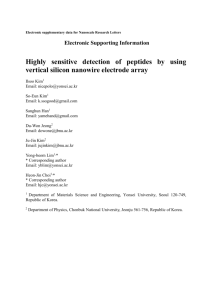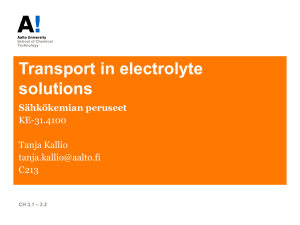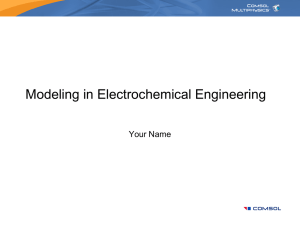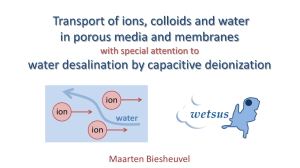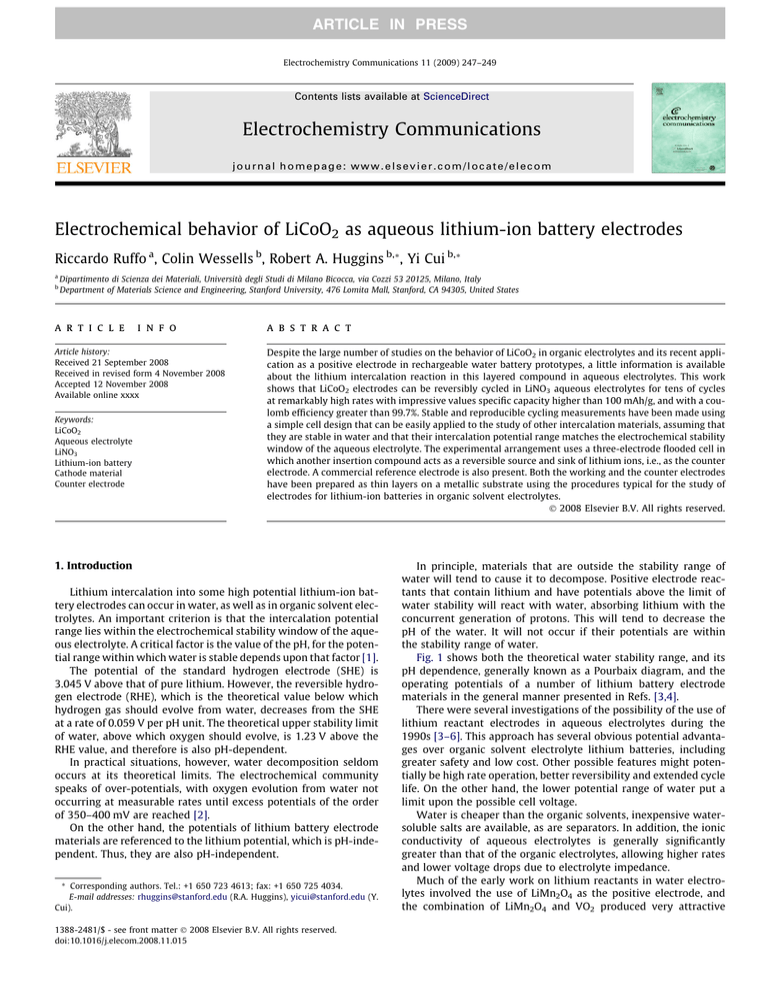
ARTICLE IN PRESS
Electrochemistry Communications 11 (2009) 247–249
Contents lists available at ScienceDirect
Electrochemistry Communications
journal homepage: www.elsevier.com/locate/elecom
Electrochemical behavior of LiCoO2 as aqueous lithium-ion battery electrodes
Riccardo Ruffo a, Colin Wessells b, Robert A. Huggins b,*, Yi Cui b,*
a
b
Dipartimento di Scienza dei Materiali, Università degli Studi di Milano Bicocca, via Cozzi 53 20125, Milano, Italy
Department of Materials Science and Engineering, Stanford University, 476 Lomita Mall, Stanford, CA 94305, United States
a r t i c l e
i n f o
Article history:
Received 21 September 2008
Received in revised form 4 November 2008
Accepted 12 November 2008
Available online xxxx
Keywords:
LiCoO2
Aqueous electrolyte
LiNO3
Lithium-ion battery
Cathode material
Counter electrode
a b s t r a c t
Despite the large number of studies on the behavior of LiCoO2 in organic electrolytes and its recent application as a positive electrode in rechargeable water battery prototypes, a little information is available
about the lithium intercalation reaction in this layered compound in aqueous electrolytes. This work
shows that LiCoO2 electrodes can be reversibly cycled in LiNO3 aqueous electrolytes for tens of cycles
at remarkably high rates with impressive values specific capacity higher than 100 mAh/g, and with a coulomb efficiency greater than 99.7%. Stable and reproducible cycling measurements have been made using
a simple cell design that can be easily applied to the study of other intercalation materials, assuming that
they are stable in water and that their intercalation potential range matches the electrochemical stability
window of the aqueous electrolyte. The experimental arrangement uses a three-electrode flooded cell in
which another insertion compound acts as a reversible source and sink of lithium ions, i.e., as the counter
electrode. A commercial reference electrode is also present. Both the working and the counter electrodes
have been prepared as thin layers on a metallic substrate using the procedures typical for the study of
electrodes for lithium-ion batteries in organic solvent electrolytes.
Ó 2008 Elsevier B.V. All rights reserved.
1. Introduction
Lithium intercalation into some high potential lithium-ion battery electrodes can occur in water, as well as in organic solvent electrolytes. An important criterion is that the intercalation potential
range lies within the electrochemical stability window of the aqueous electrolyte. A critical factor is the value of the pH, for the potential range within which water is stable depends upon that factor [1].
The potential of the standard hydrogen electrode (SHE) is
3.045 V above that of pure lithium. However, the reversible hydrogen electrode (RHE), which is the theoretical value below which
hydrogen gas should evolve from water, decreases from the SHE
at a rate of 0.059 V per pH unit. The theoretical upper stability limit
of water, above which oxygen should evolve, is 1.23 V above the
RHE value, and therefore is also pH-dependent.
In practical situations, however, water decomposition seldom
occurs at its theoretical limits. The electrochemical community
speaks of over-potentials, with oxygen evolution from water not
occurring at measurable rates until excess potentials of the order
of 350–400 mV are reached [2].
On the other hand, the potentials of lithium battery electrode
materials are referenced to the lithium potential, which is pH-independent. Thus, they are also pH-independent.
* Corresponding authors. Tel.: +1 650 723 4613; fax: +1 650 725 4034.
E-mail addresses: rhuggins@stanford.edu (R.A. Huggins), yicui@stanford.edu (Y.
Cui).
1388-2481/$ - see front matter Ó 2008 Elsevier B.V. All rights reserved.
doi:10.1016/j.elecom.2008.11.015
In principle, materials that are outside the stability range of
water will tend to cause it to decompose. Positive electrode reactants that contain lithium and have potentials above the limit of
water stability will react with water, absorbing lithium with the
concurrent generation of protons. This will tend to decrease the
pH of the water. It will not occur if their potentials are within
the stability range of water.
Fig. 1 shows both the theoretical water stability range, and its
pH dependence, generally known as a Pourbaix diagram, and the
operating potentials of a number of lithium battery electrode
materials in the general manner presented in Refs. [3,4].
There were several investigations of the possibility of the use of
lithium reactant electrodes in aqueous electrolytes during the
1990s [3–6]. This approach has several obvious potential advantages over organic solvent electrolyte lithium batteries, including
greater safety and low cost. Other possible features might potentially be high rate operation, better reversibility and extended cycle
life. On the other hand, the lower potential range of water put a
limit upon the possible cell voltage.
Water is cheaper than the organic solvents, inexpensive watersoluble salts are available, as are separators. In addition, the ionic
conductivity of aqueous electrolytes is generally significantly
greater than that of the organic electrolytes, allowing higher rates
and lower voltage drops due to electrolyte impedance.
Much of the early work on lithium reactants in water electrolytes involved the use of LiMn2O4 as the positive electrode, and
the combination of LiMn2O4 and VO2 produced very attractive
ARTICLE IN PRESS
248
R. Ruffo et al. / Electrochemistry Communications 11 (2009) 247–249
Fig. 1. Electrochemical stability window for water and lithium reaction potentials for several materials in lithium-ion batteries.
results. Subsequently, there have been several investigations in
which LiCoO2 was investigated as a potential positive electrode
reactant in aqueous electrolyte systems [7–10]. As can be seen in
Fig. 1, its operating potential range in organic electrolyte cells is
not far from that of LiMn2O4. It has a relatively flat potential profile,
high charge/discharge efficiency, a rather good cycle life, and
attractive specific power properties in organic solvent electrolytes,
and is used in a number of commercial batteries.
But in none of the available publications were the properties of
LiCoO2 in aqueous electrolytes particularly favorable. For example,
the initial discharge capacity in a saturated LiNO3 electrolyte was
reported to be only 35 mAh/g at a 1 C rate, and it fell significantly
upon cycling, becoming less than 20 mAh/g after 100 cycles [8]. In
another paper [9], the initial value was 60 mAh/g at a current density of 0.2 mA/cm2, and fell to about 40 mA/cm2 after 12 cycles.
These are significantly lower than what is typically found in organic solvent electrolyte cells.
Contrary to the prior work, the experiments reported here show
that LiCoO2 can have very attractive properties in an aqueous electrolyte under favorable conditions.
As has been shown elsewhere, water is stable over a much
wider potential range than expected from its thermodynamic
properties in aqueous solutions of LiNO3. Cyclic voltammetric
experiments with a nickel electrode showed a span of about
2.4 V [9], and this has been verified in our laboratory using a stainless steel electrode. We have observed stability up to about 1.6 V
above the SHE in 1 and 5 molar solutions of LiNO3, where the pH
is 7. The theoretical limit at that pH is only 0.817 V. Thus, it is clear
that positive electrodes with potentials as high as 4.6 V vs. Li
should be stable in this aqueous solution.
This means that the use of such electrolytes can provide an
inexpensive and simple tool for preliminary investigations of possible high potential lithium battery reactants, as was pointed out
by Eftekhari [10].
tential limitation (GCPL) using Autolab PGSTAT100 and Biologic
VMP3 instruments, respectively. All the measurements in LiNO3
(from 0.1 to 5 M) aqueous electrolytes were made in a beaker cell
using a double junction Ag/AgCl (3 M KCl), a reference electrode.
For convenience, all potentials will be reported vs. the standard
hydrogen electrode (SHE). The counter electrode (CE) was a slightly
larger Li0.5Mn2O4 layer in the same electrolyte compartment. This
was prepared by delithiation of LiMn2O4 in 5 M LiNO3. X-ray diffraction measurements were performed on the electrode layers
using a PANalytical X’Pert diffractometer with Cu Ka-radiation.
The cell parameters were refined in the rhombohedral system
using the R-3m space group.
3. Results and discussion
It was mentioned earlier that we investigated the electrochemical stability window of aqueous electrolytes containing LiNO3.
They all showed a lack of decomposition up to about 1.6 V vs.
the SHE.
To understand the electrochemical behavior of LiCoO2 in the
lithium nitrate aqueous solutions, we first performed cyclic voltammetry experiments from 0.4 to 1.1 V vs. the SHE using aqueous
electrolytes containing different concentrations of LiNO3, 0.1, 1.0
and 5.0 molar. This involved the use of a platinum counter
electrode.
The results are shown in Fig. 2. The scan rate was rather low,
0.1 mV/s. In all cases, an electrochemical process was clearly observed, with current values several orders of magnitude higher
2. Experimental
Commercial LiCoO2 powder was obtained from Aldrich (99.8%
purity) and no further treatment was performed. Working electrodes (WEs) were prepared by mixing LiCoO2 powders with carbon black and an organic binder (PVDF), in a weight ratio of
80:10:10 in NMP (n-methyl pyrrolidone), also from Aldrich. After
stirring, the mixture was deposited on stainless steel foil (type
304) by dipping, and then dried at 100 °C for 1 h. The electrode
area was about 1.0 cm2, and the weight of active material was typically in the range 3–5 mg for each sample.
Electrochemical characterization was performed by the use of
both cyclic voltammetry (CV) and galvanostatic cycling with po-
Fig. 2. Cycling voltammetry of LiCoO2 electrodes at 0.1 mV/s in different LiNO3
electrolytes.
ARTICLE IN PRESS
R. Ruffo et al. / Electrochemistry Communications 11 (2009) 247–249
than were found in the same potential range in the absence of active material. Especially at the higher concentrations, the current
peaks were quite sharp, and the positions of the cathodic and anodic peak potentials were quite close. This indicates fast kinetics.
The potentials were consistent with those expected for the
insertion and extraction of lithium in LiCoO2 in organic solvent
electrolytes. X-ray diffraction experiments were also performed
upon samples below and above the current peak potentials when
going in the positive direction, as well as after the negative current
peak as the potential had returned to its original value. These results showed that the lattice parameter c had changed (from 15.3
to 15.8 Å) as the result of the positive current, and had returned
to its original value (15.3 Å) after the reverse current peak. The lattice parameter changes were consistent with what is observed
when lithium is removed, and then re-inserted into LiCoO2 using
organic solvent electrolytes.
Galvanostatic cycling experiments were undertaken to evaluate
the behavior of LiCoO2 in an aqueous electrolyte containing 5 M
LiNO3. A flooded three-electrode electrochemical cell was used for
this purpose. It included the LiCoO2 working electrode, an Ag/AgCl
reference electrode and a large counter electrode of LixMn2O4. We
believe that the use of this counter electrode, with a mass some
20 times that of the working electrode, and an initial composition
about Li0.5Mn2O4, rather than an inert material, was quite important. It allows the cell to cycle reversibly, whereas the use of some
other possible counter electrodes, such as stainless steel, nickel
mesh, or platinum foil, that have been used by others for experiments in water, is not fully reversible and can lead to a change in
the composition of the electrolyte.
The potential range of these galvanostatic experiments was limited to 0.55–1.15 V above the SHE. This corresponds to the range in
which the lithium concentration cycle from x equals 1.0–0.5 in LixCoO2 in organic solvent electrolytes. One scan, from the 25th cycle,
at a rate of 1 C is shown in Fig. 3. The potential is plotted both vs.
SHE (left-axis) and vs. Li0.5Mn2O4 CE (right-axis). Note that the
experiments were designed to assess the reversibility of LiCoO2
in an aqueous electrolyte, not to build a realistic cell. In that case
the observed capacity was 105 mAh/g.
Experiments have been conducted which involved cycling such
an electrode between these limits at a rate of 1 C. The results over
90 cycles are shown in Fig. 4a. Both the measured capacity and the
Coulombic efficiency of each cycle are shown. It is interesting to
see that the efficiency increased to very high values after the first
few cycles, so that the measured capacity hardly changed at all.
Because of these very attractive results, the influence of the current upon the capacity during cycling was investigated. The results
are shown in Fig. 4b. It can be seen that the LixCoO2 electrode
249
Fig. 4. Capacity trend vs. number of cycles at 1 C (a) and capacity trend vs. number
of cycles at different rates. 20 C results were obtained by cycling the sample up to
1.35 V vs. SHE.
maintained an attractive capacity even to quite high rates in these
aqueous electrolyte cells.
4. Conclusion
Lithium insertion and extraction can readily occur in LiCoO2 in
LiNO3 aqueous solutions using a simple three-electrode cell with a
reversible counter electrode. At salt concentrations of 5 M the
kinetics become very fast, and the cycling behavior is very impressive, even at quite high rates.
Acknowledgment
The author acknowledges support from King Abdullah University of Science and Technology.
References
[1]
[2]
[3]
[4]
[5]
[6]
[7]
Fig. 3. Charge/discharge of LiCoO2 electrode at current rate of 1 C (25th cycle).
M. Pourbaix, in: Atlas of Electrochemical Equilibria, Pergamon Press, 1966.
M.W. Kanan, D.G. Nocera, Science 321 (2008) 1072.
W. Li, W.R. McKinnon, J.R. Dahn, J. Electrochem. Soc. 141 (9) (1994) 2310.
W. Li, J.R. Dahn, J. Electrochem. Soc. 142 (6) (1995) 1742.
W. Li, J.R. Dahn, D.S. Wainwright, Science 264 (1994) 1115.
M. Zhang, J.R. Dahn, J. Electrochem. Soc. 143 (1996) 2730.
Y.-g. Wang, J.-y. Luo, C.-x. Wang and Y.-y. Xia, J. Electrochem. Soc. A1425
(2006) 153.
[8] G. Wang, L. Fu, N. Zhao, L. Yang, Y. Wu, H. Wu, Angew. Chem. Int. Ed. 46 (2007)
295.
[9] G.J. Wang, N.H. Zhao, L.C. Yang, Y.P. Wu, H.Q. Wu, R. Holze, Electrochim. Acta
52 (2007) 4911.
[10] A. Eftekhari, Electrochim. Acta 47 (2001) 495.

